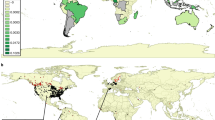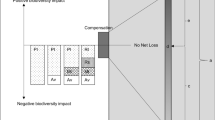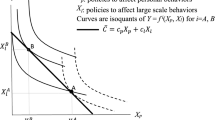Abstract
Biodiversity offsets are becoming increasingly common across a portfolio of settings: national policy, voluntary programs, international lending, and corporate business structures. Given the diversity of ecological, political, and socio-economic systems where offsets may be applied, place-based information is likely to be most useful in designing and implementing offset programs, along with guiding principles that assure best practice. We reviewed the research on biodiversity offsets to explore gaps and needs. While the peer-reviewed literature on offsets is growing rapidly, it is heavily dominated by ecological theory, wetland ecosystems, and U.S.-based research. Given that majority of offset policies and programs are occurring in middle- and low-income countries, the research gaps we identified present a number of risks. They also present an opportunity to create regionally based learning platforms focused on pilot projects and institutional capacity building. Scientific research should diversify, both topically and geographically, in order to support the successful design, implementation, and monitoring of biodiversity offset programs.


Similar content being viewed by others
References
Bekessy, S., B. Wintle, D.B. Lindenmayer, M.A. Mccarthy, M. Colyvan, M.A. Burgman, and H.P. Possingham. 2010. The biodiversity bank cannot be a lending bank. Conservation Letters 3: 151–158.
Benabou, S. 2014. Making up for lost nature? A critical review of the international development of voluntary biodiversity offsets. Environment and Society: Advances in Research 5: 103–123.
BenDor, T., N. Brozovic, and V.G. Pallathucheril. 2008. The social impacts of wetland mitigation policies in the United States. Journal of Planning Literature 22: 341–357.
BenDor, T., and A. Stewart. 2011. Land use planning and social equity in North Carolina’s compensatory wetland and stream mitigation programs. Environmental Management 47: 239–253.
Bovarnick, A., C. Knight, and J. Stephenson. 2010. Habitat banking in Latin America and Caribbean: A feasibility assessment. United Nations Development Programme.
Bull, J.W., K.B. Suttle, A. Gordon, N.J. Singh, and E.J. Milner-Gulland. 2013. Biodiversity offsets in theory and practice. Oryx 47: 369–380.
Bunn, D., M. Lubell, and C.K. Johnson. 2013. Reforms could boost conservation banking by landowners. California Agriculture 67: 86–95.
Business and Biodiversity Offsets Programme. 2009. Biodiversity Offset Implementation Handbook Washington, DC Retrieved December, 2014 from, www.forest-trendsorg/biodiversityoffsetprogram/guidelines/oihpdf.
Business and Biodiversity Offsets Programme. 2012. Standard on biodiversity offsets, A tool to assess adherence to the BBOP Principles on Biodiversity Offset Design and Implementation BBOP, Washington D.C., US.
Carroll, N., J. Fox, and R. Bayon. 2008. A guide to setting up and running biodiversity credit trading systems. In Conservation and biodiversity banking, ed. N. Carrol, J.F. Bayon, and R. Bayon, 3–8. London: Earthscan.
Cochrane, J.F., E. Lonsdorf, T.D. Allison, and C.A. Sanders-Reed. 2015. Modeling with uncertain science: estimating mitigation credits from abating lead poisoning in Golden Eagles. Ecological Applications 25: 1518–1533.
Coggana, A., E. Buitelaarc, S.M. Whittend, and J. Bennett. 2013. Intermediaries in environmental offset markets, actions and incentives. Land Use Policy 32: 145–154.
Donlan, C.J. 2015. Proactive strategies for protecting species: pre-listing conservation and the Endangered Species Act. Berkeley, CA: University of California Press.
Doswald, N., H.M. Barcellos, M. Jones, E. Pilla, and I. Mulder. 2012. Biodiversity offsets, voluntary and compliance regimes. A review of existing schemes, initiatives and guidance for financial institutions UNEP-WCMC, Cambridge, UK UNEP FI, Geneva, Switzerland.
Fairhead, J., M. Leach, and I. Scoones. 2012. Green grabbing: A new appropriation of nature? The Journal of Peseant Studies 39: 237–261.
Gelcich, S., and C.J. Donlan. 2015. Incentivizing biodiversity conservation with artisanal fishing communities through territorial user rights and business model innovation. Conservation Biology 29(1076–1085): 1011. doi:10.1111/cobi12477.
Gonçalves, B., A. Marques, A.M.V.D.M. Soares, and H.M. Pereira. 2015. Biodiversity offsets, from current challenges to harmonized metrics. Current Opinion in Environmental Sustainability 14: 61–67.
Githiru, M., M.W. King, P. Bauche, C. Simon, J. Boles, C. Rindt, and R. Victurine. 2015. Should biodiversity offsets help finance underfunded protected areas? Biological Conservation 191: 819–826.
Maron, M., A. Gordon, B.G. Mackey, H. Possingham, and J. Watson. 2015. Conservation, stop misuse of biodiversity offsets. Nature 523: 401–403.
McAfee, K. 2012. The contradictory logic of global ecosystem services markets. Development and Change 43: 105–131.
McKenney, B.A., and J.M. Kiesecker. 2010. Policy development for biodiversity offsets, a review of offset frameworks. Environmental Management 45: 165–176.
Moreno-Mateos, D., M.E. Power, F.A. Comín, and R. Yockteng. 2012. Structural and functional loss in restored wetland ecosystems. PLoS Biology 10: e1001247.
Osborne, T., and C. Kiker. 2005. Carbon offsets as an economic alternative to large-scale logging: A case study in Guyana. Ecological Economics 52: 481–496.
Pascoe, S., C. Wilcox, and C.J. Donlan. 2011. Biodiversity offsets: A cost-effective interim solution to seabird bycatch in fisheries? PLoS One 6(10): e25762. doi:10.1371/journal.pone.0025762.
Penca, J. 2013. Marketing the market: The ideology of market mechanisms for biodiversity conservation. Transnational Environmental Law 2: 235–257.
Quétier, F., and S. Lavorel. 2011. Assessing ecological equivalence in biodiversity offset schemes, key issues and solutions. Bilogical Conservation 144(12): 2991–2999. doi:10.1016/j.biocon.2011.09.002.
Rainey, H.J., E.H.B. Pollard, G. Dutson, J.M.M. Ekstrom, S.R. Livingstone, H.J. Temple, and J.D. Pilgrim. 2015. A review of corporate goals of No Net Loss and Net Positive Impact on biodiversity. Oryx 49: 232–238.
Robertson, M., and N. Hayden. 2008. Evaluation of a market in wetland credits: Entrepreneurial wetland banking in Chicago. Conservation Biology 22: 636–646.
Siikamäki, J., J.N. Sanchirico, and S.L. Jardine. 2012. Global economic potential for reducing carbon dioxide emissions from mangrove loss. Proceedings of the National Academy of Sciences USA 109: 14369–14374.
Stone, H. 2002. Graphically modeling stakeholder value. Journal of the American Water Resources Association 38: 1019–1026.
van Kooten, G.C., A.J. Eagle, J. Manley, and T. Smolak. 2004. How costly are carbon offsets? A meta-analysis of carbon forest sinks. Environmental Science & Policy 7: 239–251.
Villarroya, A., A.C. Barros, and J. Kisesecker. 2014. Policy development for environmental licensing and biodiversity offsets in Latin America. PLoS One. doi:10.1371/journal.pone.0107144.
Acknowledgments
We thank Financiamiento Basal FB-0002, nucleo-milenio initiative P10-033 and NC-120086 from the Ministerio de Economia, Fondecyt 1160145, The Walton Family Foundation and The Pew Marine Conservation Fellowship Program. We thank Veronica Ortiz and for support with the figures. We thank three anonymous reviewers that improved an earlier version of this paper.
Author information
Authors and Affiliations
Corresponding authors
Electronic supplementary material
Below is the link to the electronic supplementary material.
Rights and permissions
About this article
Cite this article
Gelcich, S., Vargas, C., Carreras, M.J. et al. Achieving biodiversity benefits with offsets: Research gaps, challenges, and needs. Ambio 46, 184–189 (2017). https://doi.org/10.1007/s13280-016-0810-9
Received:
Revised:
Accepted:
Published:
Issue Date:
DOI: https://doi.org/10.1007/s13280-016-0810-9




